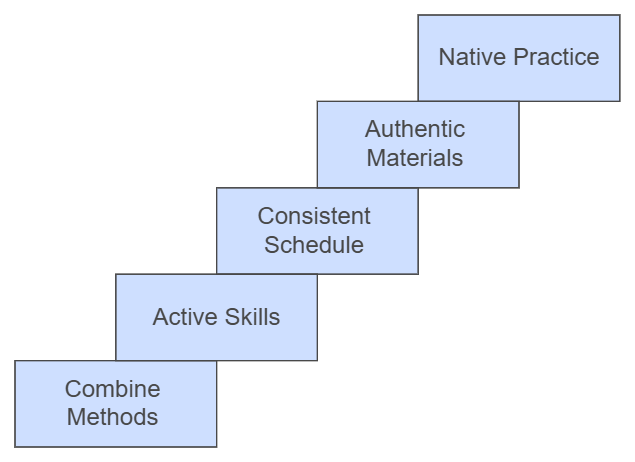How Long Does It Take to Learn French C1 Level? A Complete Timeline Guide
Reaching French C1 level typically takes between 850-900 hours of dedicated study for English speakers. However, this timeline can vary significantly based on several factors, including your learning method, study intensity, and personal circumstances.
Key Takeaways
- Achieving C1 French requires approximately 850-900 hours of structured learning
- Intensive study can reduce timeline to 3-6 months
- Part-time learners usually need 18-24 months
- Previous language experience can accelerate progress
- Success depends more on study quality than total hours
Understanding C1 Level French Proficiency
At C1 level, you can effectively use French for professional and academic purposes. You’ll understand complex texts, express ideas fluently, and handle challenging conversations with native speakers. Think of it as being able to watch French movies without subtitles or handle a job interview in French.
Progressive Learning Timeline
| Level | Study Hours | Key Milestones | Typical Duration |
|---|---|---|---|
| A1 | 80-100 | Basic communication | 2-3 months |
| A2 | 100-120 | Daily conversations | 3-4 months |
| B1 | 150-180 | Independent user | 4-5 months |
| B2 | 200-250 | Professional capacity | 5-6 months |
| C1 | 250-300 | Near-native fluency | 6-8 months |
Factors Affecting Learning Speed
Your journey to C1 French depends on several key factors that can either accelerate or slow down your progress:
Native Language Background
- Romance language speakers progress 30-40% faster
- English speakers have moderate advantage due to shared vocabulary
- Asian language speakers may need 20-30% more study time
Study Environment Impact Living in a French-speaking country can reduce learning time by up to 50% through:
- Daily immersion in the language
- Regular interaction with native speakers
- Constant exposure to authentic materials
Scientific Approach to Learning
Recent cognitive research has revealed optimal learning patterns:
- Spaced Repetition: Study in 25-30 minute intervals
- Active Recall: Practice retrieving information regularly
- Immersive Learning: Combine multiple learning methods
Technology-Enhanced Learning
Modern tools have revolutionized language acquisition:
AI-Powered Applications
- Adaptive learning algorithms
- Personalized study plans
- Real-time pronunciation feedback
Virtual Immersion
- Online language exchange
- Virtual reality conversation practice
- Interactive video content
Cost-Benefit Analysis
Understanding the investment required helps set realistic expectations:
| Learning Method | Monthly Cost | Time to C1 | Total Investment |
|---|---|---|---|
| Self-study | $50-100 | 18-24 months | $900-2400 |
| Group Classes | $200-400 | 12-18 months | $2400-7200 |
| Private Tutor | $400-800 | 8-12 months | $3200-9600 |
| Immersion Program | $1500-3000 | 3-6 months | $4500-18000 |
Success Strategies
To optimize your learning journey:
Daily Habits
- Practice speaking for 30 minutes
- Listen to French content during commutes
- Read French news articles
- Write short journal entries
Motivation Maintenance
- Set achievable monthly goals
- Track progress with language apps
- Join French learning communities
- Celebrate small victories
Professional Applications
C1 French proficiency opens significant career opportunities:
Career Benefits
- 10-20% higher salary potential
- Access to international job markets
- Enhanced promotion opportunities
- Competitive advantage in global companies
Expert Recommendations
Language acquisition specialists suggest:
- Combine multiple learning methods
- Focus on active production skills
- Maintain consistent study schedule
- Use authentic materials
- Practice with native speakers regularly

Practical Implementation
Create a balanced weekly schedule:
- 2-3 hours structured learning
- 1-2 hours conversation practice
- 1 hour reading and writing
- Daily passive listening
Conclusion
Reaching French C1 level is an achievable goal with proper planning and dedication. While the average 850-900 hours might seem daunting, structured learning and consistent practice can significantly reduce this timeline. Remember that everyone’s journey is unique, and focusing on steady progress rather than speed often leads to better long-term results.
This comprehensive approach, combining traditional methods with modern technology and scientific insights, provides the most efficient path to C1 proficiency. The key is maintaining consistent effort while using varied learning techniques to keep engagement high and progress steady.
